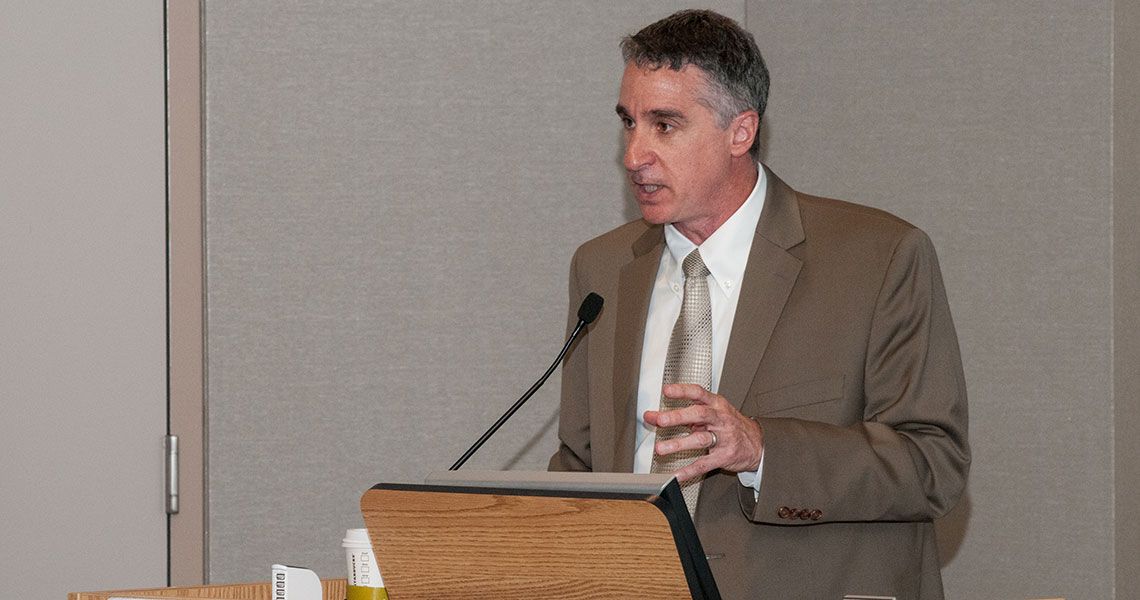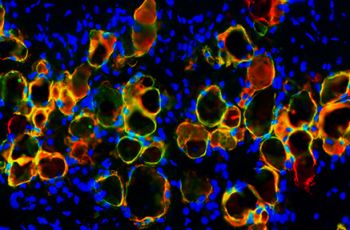Curing disease — it’s an ambitious effort befitting the finest physicians. Often, however, it’s also an objective mired the lexicon of hope rather than emerging in the realm of achievement. Before a packed audience in the GW Hospital auditorium, however, David L. Porter, M.D., cited data from years of research and clinical trials suggesting he and a team of investigators at University of Pennsylvania (UPA) might be on the verge of accomplishing that very goal.
As the 7th Annual Alpha Omega Alpha Visiting Professor, Porter, the Jodi Fisher Horowitz Professor in Leukemia Care Excellence and director of Blood and Marrow Transplantation at UPA, presented his lecture titled, “Reprogramming Human T-Cells to Treat Leukemia.” In his remarks, Porter detailed efforts to employ targeted cellular therapy to cure Chronic Lymphocytic Leukemia (CLL) as well as Acute Lyphoblastic Leukemia (ALL).
“We’ve been doing this for seven years now,” said Alan Wasserman, M.D., Eugene Meyer Professor of Medicine, chair of the Department of Medicine at the GW School of Medicine and Health Sciences (SMHS), and councilor of the Alpha Chapter of the Alpha Omega Alpha Medical Honor Society. He added that the annual grand rounds lecture serves as the perfect opener for the graduation weekend events."
With the aid of a “living” drug delivered on the back of an HIV lentivirus rendered harmless, Porter and the team train T-cells to target the CD19 antigen expressed by certain types of white blood cells. Once reintroduced in the patient, these T-cells multiply and seek out cancer cells and kill them. Essentially, researchers are reprogramming the human immune system to treat cancer, redirecting immune cells to specifically target cancer cells. “For every cell we ‘put in,’ ” explained Porter, “an estimated 93,000 cancer cells are killed.”
As one might expect, the response to Porter’s work has been enormous. Although, he said, the results thus far are “based on outcomes in limited number of patients, the work has really caught the imagination of the medical community.”
In recent years, physicians have grown adept identifying biomarkers that can determine a patient’s prognosis. However, according to Porter, regardless of what physicians believe, by the time that patient has had multiple relapses the prognosis is dismal. “The only hope is a bone marrow transplant (BMT), but that is associated with extensive morbidity and mortality,” he said.
Fewer than half of patients survive beyond a year once they are no longer responsive to standard leukemia therapies. Once a patient has active, or refractory, disease, even BMT is ineffective.
Clinical trials began in 2010 with 32 patients with CLL and 30 patients will ALL. The research team identified patients with a prognosis of less than two years, with key criteria being that patients had to have twice failed in treatment and progressed in their disease within two years from their last treatment.
In both trials, the targeted cellular therapy showed dramatic results. Investigators estimated that the treatment eliminated between three and seven pounds of tumor per-patient. In the case of the CLL patients, the pilot study yielded remarkable results. “Using all measures of remission,” explained Porter, “these patients have no evidence of CLL. More importantly, they are approaching four years of complete remission, and these were patients who had failed in all other treatment options.”
While the response rate for CLL patients in a broader trial was not as dramatic as the 100 percent remission rate investigators saw with their first three patients, just under half of these advanced patients experienced very significant responses. In the case of the trials with ALL patients, of the 30 patients in the group, 90 percent experienced a remission with just three patients showing no response to the therapy.
In closing, Porter acknowledged the extensive team of colleagues working with him on this extraordinary therapy, quoting a plaque he saw outside Fantasy Land in Disney World, attributed to Walt Disney, saying “Whatever we accomplish belongs to our entire group, a tribute to our combined effort.” However, the people, says Porter, who deserve the most recognition are the patients. “None of this could be accomplished without the remarkable grace and bravery of a group of patients who are running out of options and are willing to undergo these clinical trials with gene modified immune cells,” says Porter.



